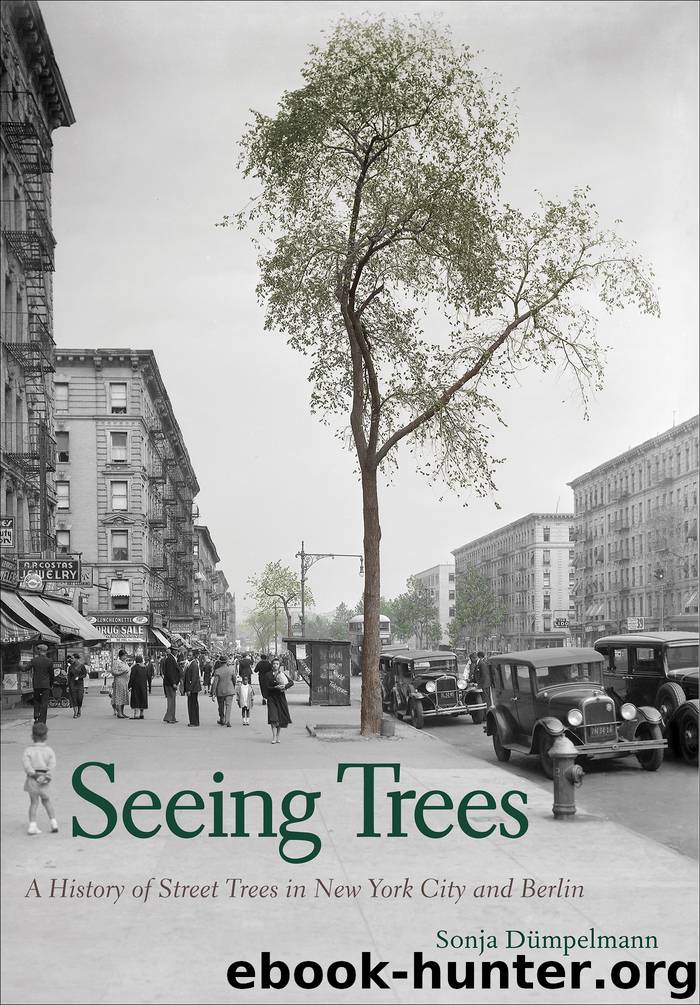Seeing Trees by Sonja Dümpelmann

Author:Sonja Dümpelmann
Language: eng
Format: epub
Publisher: Yale University Press
Published: 2019-03-04T16:00:00+00:00
FIGURE 6.8. Sketches illustrating the sound protection provided by different types of plantings along Potsdamer Chaussee. (R. Dittmann, “Öffentliche Grünanlagen, ein Faktor zur Lärmbekämpfung,” Das Gartenamt 7, no. 8 [1958]: 175–80)
Due to street trees’ location along traffic arteries, many tree experts considered them more effective than park trees when it came to abating noise, binding dust, and ameliorating climate. To increase street tree density, by the 1970s, one hundred trees per street kilometer was cited in West German specialist literature as an ideal value, a goal aspired to by West Berlin’s Senate.53
To counter occasional arguments that trees did not belong in cities, where they disturbed and endangered traffic, researchers had already in the postwar years begun to elaborate on street trees’ roles in traffic guidance. In East Berlin, Alfred Hoffmann had explored trees as elements that structured transportation space and could provide visual guidance to automobile drivers and protection to pedestrians. In cities built according to the GDR’s Sixteen Principles of Urban Planning, transportation space was to accommodate all types of movement, and trees provided a valuable structuring element that could increase security as long as they were not planted too close to each other, obstructing sightlines and views, and as long as they were maintained properly. As Hoffmann showed, the distance between trunks should depend upon the expected traffic speed (figure 6.10). Along thoroughfares where higher speeds were anticipated, a fifteen-meter distance between trunks was considered ideal for drivers to have sufficient range of view over the traffic space ahead of them. Hoffmann’s East German elaborations, which built on data provided by Soviet colleagues, in turn informed the recommendations published in the 1970s by landscape architect Aloys Bernatzky for a professional West German audience. According to Bernatzky, the minimum space between trees was to be ten meters, a value that complied with the minimum density believed necessary for the trees’ benefits for public health.54
Download
This site does not store any files on its server. We only index and link to content provided by other sites. Please contact the content providers to delete copyright contents if any and email us, we'll remove relevant links or contents immediately.
Turbulence by E. J. Noyes(7038)
The Thirst by Nesbo Jo(5785)
Gerald's Game by Stephen King(3918)
Be in a Treehouse by Pete Nelson(3212)
Marijuana Grower's Handbook by Ed Rosenthal(3118)
The Sprouting Book by Ann Wigmore(3052)
The Red Files by Lee Winter(2913)
The Remains of the Day by Kazuo Ishiguro(2617)
Sharp Objects: A Novel by Gillian Flynn(2445)
Christian (The Protectors Book 1) by L. Ann Marie(2394)
Organic Mushroom Farming and Mycoremediation by Tradd Cotter(2307)
The Culinary Herbal by Susan Belsinger(2060)
Stone Building by Kevin Gardner(1995)
The Starter Garden Handbook by Alice Mary Alvrez(1924)
Lilac Girls by Martha Hall Kelly(1871)
The Unlikely Pilgrimage of Harold Fry by Rachel Joyce(1836)
The Lean Farm Guide to Growing Vegetables: More In-Depth Lean Techniques for Efficient Organic Production by Ben Hartman(1784)
Urban Farming by Thomas Fox(1749)
Backyard Woodland by Josh VanBrakle(1587)
